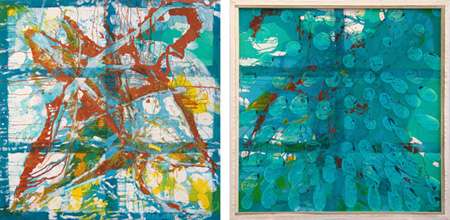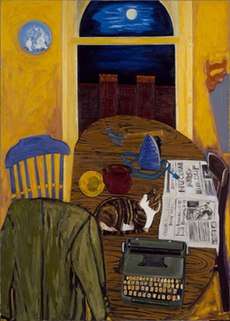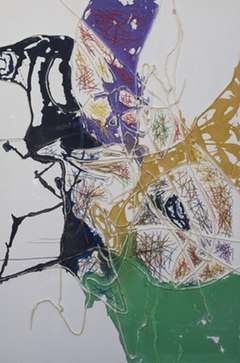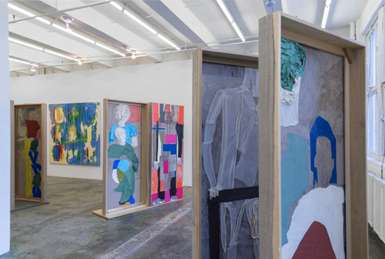Dona Nelson
Dona Nelson (born 1947) is an American painter, best known for immersive, gestural, primarily abstract works employing unorthodox materials, processes and formats to disrupt conventional notions of painting and viewership.[1][2] A 2014 New Yorker review observed, "Nelson gives notice that she will do anything, short of burning down her house to bully painting into freshly spluttering eloquence."[3] Since 2002, long before it became a more common practice,[4][5] Nelson has produced free-standing, double-sided paintings that create a more complex, conscious viewing experience.[6][7] According to New York Times critic Roberta Smith, Nelson has dodged the burden of a "superficially consistent style," sustained by "an adventuresome emphasis on materials" and an athletic approach to process that builds on the work of Jackson Pollock.[2] Writers in Art in America and Artforum credit her experimentation with influencing a younger generation of painters exploring unconventional techniques with renewed interest.[8][9] Discussing one of Nelson's visceral, process-driven works, curator Klaus Kertess wrote, the paint-soaked "muslin is at once the tool, the medium, and the made."[1]

Dona Nelson | |
|---|---|
| Born | 1947 (age 72–73) Grand Island, Nebraska, United States |
| Education | Whitney Museum Independent Study Program, Ohio State University |
| Occupation | Painter, Academic teacher |
| Organization | Tyler School of Art |
| Awards | Anonymous Was a Woman, Foundation for Contemporary Arts, Guggenheim Memorial Fellowship |
| Website | Dona Nelson |
Nelson has exhibited nationally and internationally, including solo shows at the Weatherspoon Art Museum and Tang Museum (survey, 2018), and group exhibitions at the Aldrich Contemporary Art Museum, Rose Art Museum, Mary Boone Gallery and Marlborough Fine Art.[10][11][12][13] Her two-sided paintings featured in the 2014 Whitney Biennial were widely recognized[14][15] and deemed some of the show's "most swooned-over works" by Art in America.[16] Nelson has been awarded a Guggenheim Fellowship (1994)[17] and her work sits in numerous public collections, including The Metropolitan Museum of Art,[18] Solomon R. Guggenheim Museum[19] and Boston Museum of Fine Arts.[20] She lives in Lansdale, Pennsylvania, and is a professor of painting and drawing at the Tyler School of Art at Temple University, where she has taught since 1991.[21]
Life and career
Nelson was born in 1947 in Grand Island, Nebraska and attended Ohio State University. In the fall of 1967, she moved to New York City to participate in the newly-formed Whitney Museum Independent Study Program.[22] After returning to Ohio to complete her BFA in 1968, she moved to Lower Manhattan, renting a loft in what is now SoHo; five years later, she would move to another in the future Tribeca neighborhood. By 1971, she was featured in prominent shows such as "Twenty‐Six Contemporary Women Artists," curated by Lucy Lippard at the Aldrich Museum,[23] and "Ten Young Artists" at the Guggenheim Museum.[24] Critics Grace Glueck and Hilton Kramer noted her work in New York Times reviews of the two shows, respectively.[11][25] In 1974, the Whitney Museum included her in its "Continuing Abstraction in American Art" exhibition;[26] her first solo show followed at the Rosa Esman Gallery on 57th Street, in 1975.

In the 1980s and 1990s, Nelson exhibited at museums, universities, and the Hamilton and Michael Klein galleries in New York.[10] She moved to Philadelphia in 1996, to continue teaching at the Tyler School of Art. Nelson has continued to show actively in New York, at Cheim and Read and the Thomas Erben Gallery, which has represented her since 2006.[10]
Work
Although Nelson has created representational images, she has primarily worked in a fluid, abstract vein that writers suggest confront the traditions of Abstract Expressionism head-on and build on Joan Miró's anti-paintings, which used nontraditional materials and processes to disrupt painting conventions.[27][8][28] Artforum likened her "exhilarating" willingness to take risks to that of Sigmar Polke.[29] Critics especially note her "adventurously tough-minded approach to process," which "flirts with painting’s destruction"[8] by rejecting the "conventionally ingratiating"[30] in favor of dissonant techniques, surfaces, and colors. Noting Nelson's anarchic refusal to adhere to an easily identifiable style, writers have observed that her exhibitions can appear like compendiums of modern and contemporary painting thought.[31]
Nelson regards herself as a process artist rather than an expressionist, emphasizing the primacy of chance, improvisation, and touch in her process.[7] She employs diverse methods—pouring, staining, splattering, stitching, and more[32][27]—working on unprimed canvas with a variety of paints, nontraditional materials, and at times, a painting's stretchers to create unexpected surfaces, textures, reliefs, and patterns (sometimes referencing the Modernist grid).[6][8]
Early work: 1968–1990
Nelson's early art explored geometric, grid-based abstraction through intuitive and systematic modes of pictorial construction; reviewers noted it for its grasp of style,[25] subtle color, and affinities with art by Agnes Martin and Ellsworth Kelly.[11][19] Considering this work developmental, she eventually destroyed it. In the 1980s, Nelson shifted to painterly representational work (e.g., Daily News, 1983) featuring ordinary interiors, landscapes and cityscapes, portrayed with an emotional realism and unfussy physicality.[33][34][35] Figurative paintings, such as Summer Man (1983),[36] offered centralized, life-size everyday subjects that The New York Times wrote, display a plain-spoken, "satisfying solidity" like those of Philip Guston; later works, such as California Landscape or the Man Who Needs Everything (1988),[37] presaged future directions with glued, clothing-like pieces of muslin, saturated color, and increasing abstraction.[38][34]
Mature work (1990–2002)
Many critics (and Nelson herself) consider her mature work to have begun after a long period of development, when she returned to abstraction in the 1990s.[34][39] In this period, she regularly incorporated unconventional materials such as cheesecloth, muslin, gels, and modeling paste.[40][41] She also began employing unorthodox techniques that combined control and accident to "disrupt" her paintings, such as pouring latex enamel paint over gridded fields (the "12 Stations of the Subway" series, 1997–8), making charcoal rubbings of highly textured, existing paintings (her ghostly "Rubbings," 2002),[42] or adhering wadded, paint-soaked muslin to canvasses.[43][44][30] Reviewers commented on the new work's collision of "formal order and procedural chaos,"[13] and raw and finished, which they found both dislocating and inviting, its power deriving from a "freeze-framing" of the painting process that revealed a series of discrete, nonlinear acts and decisions.[30][43][45] Describing this passage in Nelson's work through the painting Octopus Blue (1990), Klaus Kertess wrote, "We are confronted by an organism wrestling with its self-formation—complex, mysterious, fierce, playful, sensual."[1]

Two-sided paintings and "Box" constructions (2002– )
In 2002, Nelson began creating two-sided works one writer called a "nervy push" of "painterly painting into the realm of sculpture."[5][22] Critics noted works like Gaucho Groucho (2005), String Turn (2015) and Coins in a Fountain (2015) for their increasing inventiveness and sense of performance,[46][6] "adamant, difficult beauty" and "elaborate narratives of process,"[4] which included punching holes through the canvas and working back and forth between sides, staining through sides, removing and re-stretching canvasses, and more.[7][2] David Pagel argues that this work "builds memory into the process, creating experiences that are greater than the sum of their parts – and far more mysterious."[6] The New York Times wrote, "The paintings... demand that you deal with how they came to be that way… mysteries mount, resolve and mount again."[27] Nelson explains that her exhibition constructions—using steel stands, platforms, bricks and cable—seek a more conscious, intimate viewing process countering the artificiality of typical, "big white box-style" contemporary art spaces, which privilege the reification of art over engagement and the complexity of surface.[47][48]

In 2016, Nelson returned to the figure in her two-sided, variously constructed "Box" works[49]—free-standing, door-sized painted panels that verge on architecture and continue to employ unconventional materials and processes.[4][22] Critics describe installations of the work, such as her 2017 show "Models Stand Close to the Paintings,"[50] as a "loose, kaleidoscopic maze of contrasting viewpoints" and interacting works—a sense furthered by the central, abstracted figures Nelson portrays in them.[4][22][51] Critics such as Dan Cameron noted Nelson's disruption of the frontality of conventional painting, as well as the evolution of the physical presence of her two-sided works into a new, metaphorical level.[52][53]
Awards and collections
Nelson has been recognized with awards and grants from Anonymous Was a Woman (2015),[54] Artist Legacy Foundation (2013), Foundation for Contemporary Arts (2011),[55] Tesuque Foundation (peer nominated, 2000), and the John Simon Guggenheim Memorial Fellowship (1994).[17] Her work resides in many public collections, including The Metropolitan Museum of Art,[18] Solomon R. Guggenheim Museum,[19] Boston Museum of Fine Arts,[20] Art Gallery of New South Wales,[56] Albright–Knox Art Gallery,[57] Pennsylvania Academy of Fine Arts,[36] Weatherspoon Art Museum,[58] Rose Museum,[59] among others, and several corporate collections.
References
- Kertess, Klaus. "Full Nelson," Dona Nelson: The Stations of the Subway, Octopuses and Arrangements, Exhibition catalogue, Greensboro, NC: Weatherspoon Art Museum, 2000.
- Smith, Roberta. "Art in Review, Dona Nelson," The New York Times, May 23, 2008, p. E26.
- The New Yorker. "Dona Nelson," Goings on About Town: Art, The New Yorker, May 12, 2014.
- Smith, Roberta. "What to See in New York Art Galleries This Week," The New York Times, May 10, 2017. Retrieved November 20, 2018.
- McQuaid, Cate. "Ornate, pushy, celebratory – yet all compatible," The Boston Globe, September 19, 2012.
- Pagel, David. "Renegade abstractions of Polly Apfelbaum and Dona Nelson make for a stellar art show," Los Angeles Times, March 18, 2016. Retrieved November 20, 2018.
- Meskin, Leeza. "DONA NELSON with Leeza Meksin," The Brooklyn Rail, July 11, 2018. Retrieved November 20, 2018.
- Kreimer Julian. "Dona Nelson," Art in America, June/July 2014, p. 140-141. Retrieved November 20, 2018.
- Hunter, Becky Huff. "Painters Sculpting/Sculptors Painting," Artforum, May 2017, Retrieved November 26, 2018.
- Tang Museum. "Dona Nelson: Stand Alone Paintings," Exhibitions, 2018. Retrieved November 26, 2018.
- Glueck, Grace. "The Ladies Flex Their Brushes," The New York Times, May 30, 1971. Retrieved November 26, 2018.
- Smith, Roberta. "Helen Frankenthaler’s Influence on the Art World," The New York Times, June 3, 2017. Retrieved November 20, 2018.
- Johnson, Ken. Review, The New York Times, May 1, 1998. Retrieved November 26, 2018.
- Schjeldahl, Peter. "Get With It: The Whitney Biennial," The New Yorker, March 17, 2014. Retrieved November 20, 2018.
- Saltz, Jerry. "Seeing Out Loud: There’s a Smart Show Struggling to Get Out of this Big, Bland Whitney Biennial," Vulture, March 5, 2014. Retrieved November 20, 2018.
- Art in America. "Dona Nelson," Exhibitions, Art in America, May 1, 2014. Retrieved November 20, 2018.
- John Simon Guggenheim Memorial Fellowship. Dona Nelson, 1994, Fellows. Retrieved November 27, 2018.
- The Metropolitan Museum of Art. "Dona Nelson," Collection. Retrieved November 26, 2018.
- Solomon R. Guggenheim Museum. "Ten Young Artists: Theodoron Awards," Publications. Retrieved November 26, 2018.
- Boston Museum of Fine Arts. Dona Nelson, String Beings, 2013, Collections. Retrieved November 26, 2018.
- Tyler School of Art. "Dona Nelson," Faculty. Retrieved November 26, 2018.
- Pardee, Hearne. "Shared Spaces: Dona Nelson Brings Back The Figure," artcritical, April 20, 2017. Retrieved November 26, 2018.
- Lippard, Lucy. "26 Contemporary Women Artists," Exhibition catalogue, Ridgefield, CT: Aldrich Museum of Contemporary Art, 1971.
- Schjeldahl, Peter. "And Now a ‘Teddy’ for the Artist," The New York Times, October 17, 1971. Retrieved November 26, 2018.
- Kramer, Hilton. "Guggenheim Shows 10 Young Artists," The New York Times, September 25, 1971. Retrieved November 20, 2018.
- Schjeldahl, Peter. "New Abstract Painting: A Variety of Feelings," The New York Times, October 13, 1974. Retrieved November 26, 2018.
- Smith, Roberta. "Dona Nelson: Phigor," The New York Times, May 8, 2014. Retrieved November 20, 2018.
- Maine, Stephen. "Dona Nelson at Thomas Erben," Art in America, December 2006, p. 149.
- Schwabsky Barry. "Dona Nelson," Artforum, Summer, 2014. Retrieved November 20, 2018.
- Johnson, Ken. "Dona Nelson – Tactile Image," The New York Times, January 31, 2003. Retrieved November 26, 2018.
- Doll, Nancy. Introduction Dona Nelson: The Stations of the Subway, Octopuses and Arrangements, Exhibition catalogue, Greensboro, NC: Weatherspoon Art Museum, 2000.
- Moyer, Carrie. "Dona Nelson: Brain Stain," The Brooklyn Rail, October 8, 2006. Retrieved November 26, 2018.
- Harrison, Helen A. "Something Beyond Seeing," The New York Times, March 6, 1983, Arts, p. 20. Retrieved November 20, 2018.
- Smith, Roberta. "Tales of Ordinary People Told in Bits and Pieces," The New York Times, March 31, 1989, Arts, p. 32. Retrieved November 26, 2018.
- Liebman, Lisa. "Dona Nelson," Artforum, March 1989, Retrieved November 26, 2015.
- Pennsylvania Academy of Fine Arts. "Dona Nelson," Collection. Retrieved November 26, 2018.
- Dona Nelson website. "California Landscape or the Man Who Needs Everything (1988), Paintings, Early Figures. Retrieved November 26, 2018.
- Brenson, Michael. Review, The New York Times, November 22, 1985, Arts p. 25. Retrieved November 26, 2018.
- Westfall, Stephen. "Dona Nelson at Cheim & Read," Art in America, June 2003, p. 117–118.
- Yablonsky, Linda. "Dona Nelson," Artforum, January 1994, Retrieved November 26, 2015.
- Smith, Roberta. "Testing Limits at the Corcoran," The New York Times, January 6, 1996, Arts, p. 11. Retrieved November 26, 2018.
- Dona Nelson website. Stations of the Subway, Rubbings, Paintings. Retrieved November 26, 2018.
- Smith, Roberta. Review, The New York Times, March 29, 1996. Retrieved November 26, 2018.
- The New York Times. Reviews, The New York Times, January 8, 1999.Retrieved November 26, 2018.
- Smith, Roberta. "Dona Nelson," The New York Times, February 16, 2001. Retrieved November 26, 2018.
- Cotter, Holland. "Art in Review; Dona Nelson", The New York Times, September 22, 2006. Retrieved November 26, 2018.
- Dona Nelson website. "Dona Nelson in conversation with Nicholas Chambers," Interviews, 2017. Retrieved November 26, 2018.
- Nelson, Dona. "The Mercer Museum," Art in America, December 2015, p. 60–1.
- Dona Nelson website. Exhibition Installations & Boxes, Paintings. Retrieved November 29, 2018.
- Thomas Erben Gallery. "Models Stand Close to the Paintings" exhibition (2017), Exhibitions. Retrieved November 29, 2018.
- Hughes, Millree. "Transubstantial," Culture Catch, April 17, 2017. Retrieved November 26, 2018.
- Miller, James H. "Expert Eye: Dan Cameron – Curator picks his top works at Art Basel in Miami Beach," The Art Newspaper, December 9, 2017. Retrieved November 26, 2018.
- Rodney, Seph. [ "Collaged Paintings with Presence,"] Hyperallergic, April 14, 2017. Retrieved November 26, 2018.
- Lins, Pam. "Anonymous Was A Woman Announces Awards for 2015," Artforum, May 2017, Retrieved November 2, 2015.
- Artforum. "Foundation for Contemporary Arts Announces 2011 Artist Grants," Artforum, January 19, 2011, Retrieved November 26, 2015.
- Art Gallery New South Wales. Dona Nelson, March Hare, 2014, Collection. Retrieved November 26, 2018.
- Albright-Knox At Gallery. Dona Nelson, Dutch Door, 2015, Collection. Retrieved November 26, 2018.
- Weatherspoon Art Museum. Dona Nelson, Octopus Blue, 1991–2, Collections. Retrieved November 26, 2018.
- Rose Museum. Dona Nelson, Okie Dokie, 2008, Collection. Retrieved November 26, 2018.
External links
- Dona Nelson website
- Dona Nelson interview with Leeza Meksin, The Brooklyn Rail, 2018